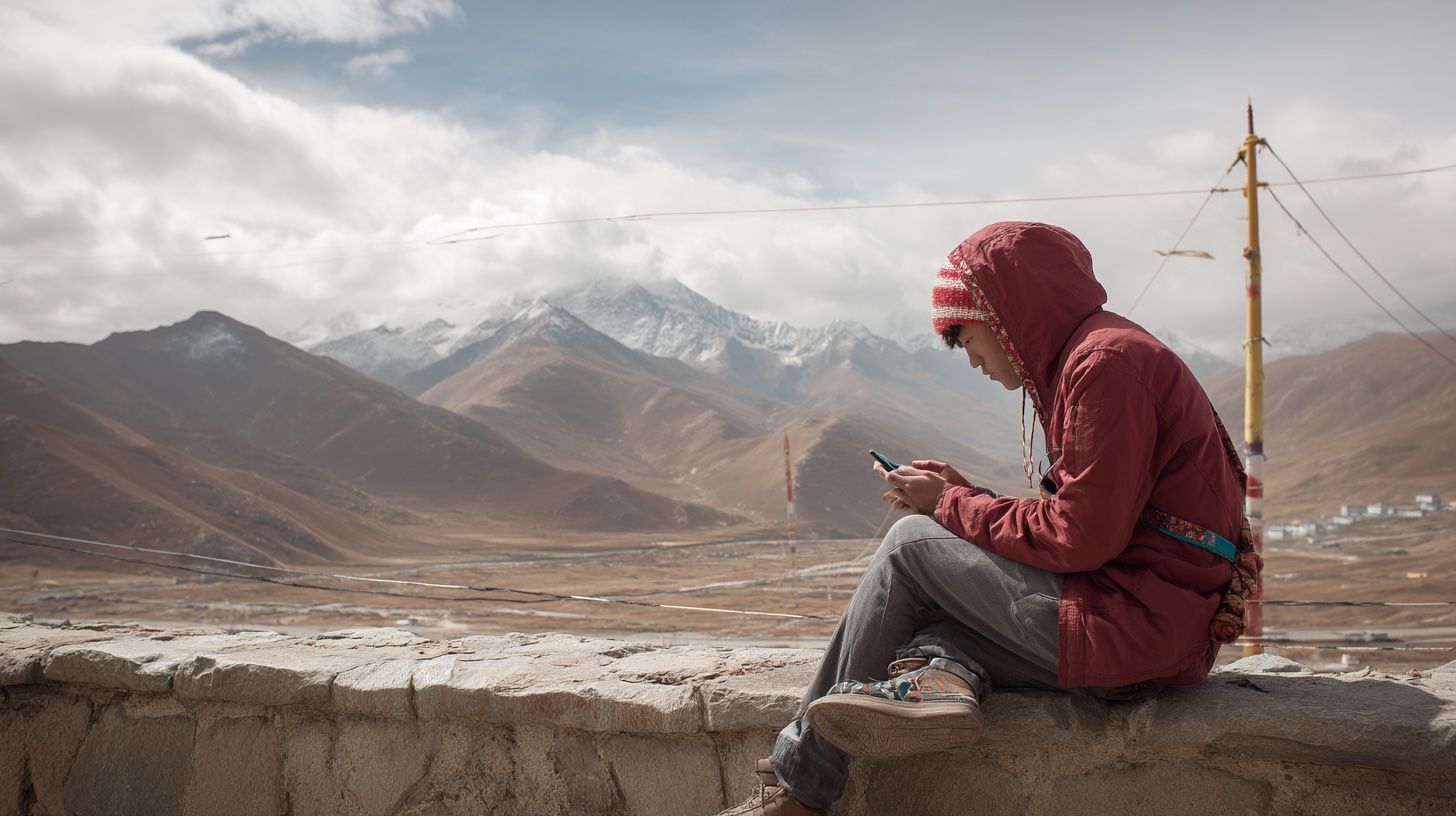- A China Mobile 5G base station was installed at Mount Everest base camp at 6,500 meters in 2020, making it the world’s highest 5G site.
- By 2019, more than 98% of Tibet’s villages had fiber‑optic broadband and 4G mobile coverage due to government investment.
- By 2018, government universal service projects connected over 5,000 villages with broadband across Tibet.
- End of 2019 Tibet had about 50,000 mobile base stations, rising to 60,500 by late 2022.
- By 2023, 5G network coverage extended to all towns in Tibet.
- By November 2022 Tibet had 1.28 million fixed broadband internet users, with 98% of those connections FTTH.
- As of late 2023 Tibet had 1.84 million 5G subscribers and about 23 5G base stations per 10,000 people.
- Urban areas host 2.41 million fixed broadband ports versus about 442,000 in rural areas, from a total of 2.85 million ports.
- In 2019 the average mobile data price fell to 5.5 yuan per GB, a 73% drop from the previous year.
- All Tibet internet traffic is subject to China’s Great Firewall, with real‑name registration required for SIM cards and home internet, and VPNs largely outlawed since 2018.
Workers install a China Mobile 5G base station at 6,500 meters elevation on Mount Everest in 2020 – the world’s highest 5G site. [1] High-speed internet has reached even the roof of the world. In China’s Tibet Autonomous Region (TAR), modern telecommunications now span from Lhasa’s city streets to the remote slopes of the Himalayas. Once isolated by geography, Tibet is increasingly connected via fiber-optic cables and cellular towers that link almost every village [2] [3]. This dramatic expansion of connectivity comes with a catch: all access is controlled by state-run providers and tightly monitored behind China’s infamous “Great Firewall” [4]. The result is a high-altitude internet boom – under intensive government surveillance. Below, we dive into Tibet’s telecom infrastructure, mobile and broadband access, digital divides, and the heavy hand of censorship shaping how Tibetans experience the internet in 2025.
Modern Infrastructure at the Roof of the World
Tibet has undergone a rapid telecom infrastructure build-out in recent years. By 2019, more than 98% of villages in the region were equipped with fiber-optic broadband and 4G mobile coverage, thanks to billions in government investment [5]. Virtually all county towns and even remote settlements now have network access. The region boasted around 50,000 mobile base stations by the end of 2019 [6], a number that grew to 60,500 by late 2022
[7]. These base stations – many powered by solar panels at high altitudes – blanket Tibet’s rugged terrain with cellular signals. Optical fiber cables snake alongside new highways and railways across the plateau, bringing high-capacity internet links to urban centers and border areas alike. In fact, 99% of Tibet’s administrative villages have broadband internet access, with only a few dozen extremely isolated hamlets remaining unconnected as of 2018 [8]. This universal connectivity drive was achieved ahead of China’s national schedule, as Tibet met rural telecom coverage targets early [9].
Such infrastructure development means that today “almost everyone has access to internet services” in Tibet [10]. Households that once relied on sporadic telephone lines or none at all can now get online even in remote counties. The government’s universal service projects connected over 5,000 villages with broadband by 2018 [11], often through subsidized fiber hookups or wireless broadband. Meanwhile, major highways like the Qinghai–Tibet route carry robust fiber backbones. In 2021 alone, Tibet installed over 3,000 new 5G base stations, reaching a total of 6,660 5G towers across the region [12]. By 2023, officials report that 5G network coverage extends to all towns in Tibet [13]. From Lhasa’s downtown to farming towns on the Nepal border, the physical infrastructure for internet access is largely in place.
Mobile Networks: From 2G to 5G in the Himalayas
Mobile telephony has been the driving force of internet penetration in Tibet. Basic 2G GSM service first reached Lhasa and a few cities in the early 2000s, and by the 2010s coverage had spread along major roads and towns with 3G and 4G. Today, 4G LTE signals blanket 98% of villages [14], enabling even nomadic herders on the grasslands to browse WeChat or make video calls. The region’s three big telecom providers – China Mobile, China Telecom, and China Unicom – all operate in Tibet, building out networks despite the extreme terrain. China Mobile, the largest carrier, has led the charge in remote coverage (often partnering with Huawei for equipment) [15] [16]. Its engineers famously activated a 5G tower at Mount Everest base camp (6,500m elevation) in 2020 [17], demonstrating the lengths China is willing to go to connect Tibet. By early 2023, Tibet had more than 9,500 5G base stations built in cities and rural counties [18], and the government aims to nearly double that to 18,000 towers by 2025 [19].
The rapid 5G rollout means ultra-fast mobile internet is increasingly common in Tibet’s population centers. As of late 2023, the region had 1.84 million 5G subscribers – roughly half its population – and about 23 5G base stations per 10,000 people, on par with China’s national average [20]. Overall mobile usage is even more widespread: by the end of 2022, 89.5% of Tibetans used mobile phones and 81% were mobile internet users
[21]. In fact, official data showed 3.3 million mobile phone users in Tibet (for a population around 3.6 million)
[22]. This suggests many residents have a cellphone, often their primary way to get online. Even traditionally isolated groups like nomadic pastoralists are now commonly seen carrying smartphones on the plateau [23]. Popular Chinese apps such as WeChat, Douyin (TikTok’s Chinese version), and Kuaishou dominate Tibetan social media usage, since Western platforms are blocked. China Mobile’s Tibet branch reported peak 5G download speeds over 500 Mbps in Lhasa during its early tests [24]– a remarkable feat at 12,000 feet elevation. Expanding that connectivity to farming villages and high mountain passeshas been a strategic priority, despite challenges of harsh weather and thin air [25].
Today, 4G and 5G signals reach all 74 county-level areas of Tibet [26], and every township has at least one 5G tower [27]. However, this doesn’t mean continuous coverage across every mile of wilderness – many remote nomadic camps rely on catching a signal from the nearest village tower, and some high Himalaya valleys remain dead zones. Still, the breadth of mobile coverage is unprecedented. According to a 2024 report, Tibet now has over 2.3 million 5G users, about a 62% penetration rate (out of ~3.65 million population) [28] [29]. This is lower than China’s national 5G uptake (which nears 96% of mobile users) [30], but extraordinary given Tibet’s sparse, mountainous terrain. Much of the rural 5G coverage is made possible by low-band 700 MHz signals (through a China Mobile–China Broadnet network sharing plan) that cover vast grassland distances better than the higher frequencies used in cities [31]. In short, from 2G only two decades ago, Tibet’s mobile network leapfrogged to modern 4G/5G connectivity virtually everywhere – bringing the internet to yurts and monasteries as well as urban offices.
Urban vs. Rural: Fixed Broadband Access
Alongside mobile networks, fixed broadband has expanded dramatically – though urban areas enjoy far better servicethan remote villages. In Lhasa and other cities, residents can subscribe to fiber-to-the-home plans providing 100 Mbps or faster speeds. By November 2022, Tibet had 1.28 million fixed broadband internet users, and 98% of these were fiber-optic (FTTH) connections
[32]. This suggests that in cities like Lhasa, Shigatse and Nyingchi, fiber broadband is ubiquitous. Indeed, nearly 81 fixed-line broadband connections per 100 households were reported in 2018 [33] – meaning most urban families had a home internet line in addition to mobile data. Thanks to massive infrastructure investment, broadband ports are plentiful: Tibet has 2.85 million broadband access ports installed, with 2.41 million in urban areas and about 442,000 in rural areas
[34]. The urban centers have clearly benefited first – Lhasa alone accounts for a large share of those ports, connecting government offices, businesses, and homes with high-speed internet.
In the countryside, fixed broadband access exists but is less utilized. Every county seat and many townships have fiber backhaul, and by 2019 officials claimed all impoverished villages were connected to broadband if they met the requirements [35]. In practice, however, fewer rural households subscribe to fixed broadband – many rely on their smartphones for internet access instead. The digital divide in Tibet is evident in these numbers: while cities have far more broadband lines than households, rural areas have relatively few per capita. A 2024 analysis noted that about 63% of Tibet’s population is rural, compared to only one-third nationwide [36], making it a challenge to serve so many remote users. Still, China’s rural fiber program reached deep into Tibet. Even farming villages at 4,000m elevation often have a government-installed optical fiber node (for example, to connect the local school or clinic), which enterprising locals can tap into. In some areas, wireless home broadband is offered using 4G/5G routers as a substitute for wired lines. This has helped extend internet service to nomadic tent dwellings and herder camps that are too transient for laying cable.
Overall, urban Tibetans enjoy reliable, fast home internet, while rural communities may only have patchy Wi-Fi from a cell network or a single village cyber café. The infrastructure gap itself is shrinking – by 2020, 80% of Tibet’s villages had internet access [37] – but a usage gap remains. Many rural Tibetans have smartphones yet lack digital literacy or trust in online services. The majority of nomads and older villagers are illiterate or only fluent in Tibetan, making the Chinese-dominated internet less accessible [38]. Younger generations, however, are increasingly savvy: they use WeChat for everything from market prices to telemedicine. In short, the physical broadband network now spans urban and rural Tibet, but urban users make far greater use of it due to better affordability, education, and local content availability. Bridging this divide is an ongoing challenge even as the cables and signals reach the villages.
Broadband Speed and Affordability in Tibet
Tibet’s internet speeds have improved greatly, while the costs have plummeted due to government policy. With fiber optic networks and 5G, users in Lhasa can enjoy download speeds comparable to eastern Chinese cities. Nearly all fixed broadband subscribers in Tibet now have 100 Mbps or higher plans [39], and gigabit (1000 Mbps) service is reportedly available in Lhasa for those who need it. Mobile 4G speeds routinely hit 30–50 Mbps in urban areas, and 5G users can get several hundred Mbps under good signal conditions – one early 5G test in Lhasa recorded peak downloads around 530 Mbps [40]. Even in rural counties, a 4G phone typically sees double-digit Mbps speeds, sufficient for video streaming and social media. The push for “network speed acceleration” (提速) has been a priority in Tibet as part of nationwide tech development. Officials claim the region’s average broadband speeds have increased every year; by 2022 a vast majority of connections were fast enough for HD video and cloud services [41].
Crucially, internet service has become far more affordable for Tibetans. The government and state carriers have enacted steep price cuts under the “speed up, fee down” campaign. In 2019, Tibet led the country in reducing mobile data fees – the average cost for mobile data fell to just 5.5 yuan per GB (≈ $0.80), a 73% drop from the previous year [42]. This made Tibet’s data tariffs among the lowest in China at the time. Fixed broadband prices have similarly been slashed: back in 2016, the average home broadband cost was 40.6 yuan ($5.80) per month, after a 31% year-on-year drop – the biggest decline in China [43]. Since then, further cuts and poverty-alleviation discounts have taken effect. By 2022, Tibet’s telecom firms were offering special low-cost packages to hundreds of thousands of low-income, disabled, or elderly users, forgoing over 220 million yuan in revenue to keep prices low [44]. Businesses also saw an average 20% drop in broadband and private line fees that year [45].
Today, a basic 100 Mbps home fiber plan in Lhasa might cost on the order of 30–50 yuan ($5–8) per month – extremely affordable by global standards (and slightly below China’s national average). Mobile plans are equally cheap: unlimited data packages are available for under 100 yuan ($15) monthly, and pay-as-you-go data is just a few yuan per GB. In rural areas, the government often subsidizes internet for villagers, effectively providing free or very cheap service to many farming families. Thanks to these policies, cost is rarely the main barrier to internet access in Tibet. Indeed, Tibet ranked #1 in China for reducing data costs in 2019 [46], reflecting Beijing’s commitment to making connectivity accessible in poorer regions. While incomes in Tibet are lower than coastal China, the relative price of internet (as a share of income) has improved significantly. The combination of high bandwidth and low cost means that, technically, a Tibetan in Lhasa can stream videos, video-chat with relatives, or take online courses as easily as someone in Beijing – if they have the digital skills and the content isn’t blocked.
The Great Firewall in Tibet: Censorship and Surveillance
Despite newfound connectivity, Tibetans face a highly restricted and surveilled internet environment. All internet traffic in Tibet is subject to China’s national censorship system, often called the “Great Firewall”, which blocks access to thousands of websites and apps [47]. Services like Google, Facebook, YouTube, Twitter, and most foreign news sites are completely inaccessible via normal connections [48]. Online content is heavily filtered for political sensitivity: any mention of Tibetan independence, the Dalai Lama, or criticism of Chinese rule is scrubbed from social media and search results. Within Tibet, authorities maintain an information bubble designed to “subjugate Tibet and its people,” according to Tibet advocacy groups [49]. The government’s strategy is twofold: limit what Tibetans can see online, and closely monitor their own communications.
All telecom operators in Tibet are state-owned or controlled, and they comply with strict internet supervision by the Cyberspace Administration of China. Real-name registration is required for SIM cards and home internet – users must show ID, so anonymity is nearly impossible online [50]. Public Wi-Fi networks (in cafés, etc.) likewise require an ID login. Surveillance is pervasive: security agencies monitor social media posts, chat messages, and emails using advanced algorithms and human censors. A 2022 human rights report noted that Chinese authorities can now monitor not only text conversations but also phone calls and voice messages, thanks to AI that can filter audio communications in real time [51]. Tibet has in many ways become “China’s laboratory for repression”, where new surveillance methods are tested [52]. For example, authorities deploy extensive CCTV camera networks in cities and even inside monasteries. Police checkpoints with facial recognition scanners are commonplace, especially in Lhasa – an idea first implemented in Tibet by hardline Party boss Chen Quanguo, then exported to Xinjiang later [53] [54]. On the digital front, these measures translate to near-total oversight of Tibetan netizens’ activities.
Website blocking and content filtering are more aggressive on topics related to Tibet. International human rights sites, Tibetan exile media, and any site mentioning “Free Tibet” are categorically blocked. Keyword filters on Chinese platforms will censor phrases in Tibetan or Chinese that hint at dissent. During sensitive anniversaries (like the March 10 uprising day), internet speeds in Tibet have reportedly been throttled or cut off entirely in the past – an extreme form of control not uncommon in restive regions of China. Communication apps are closely watched: WeChat, by far the most used chat app in Tibet, is monitored by censors who will delete messages or accounts that share banned content. Voice calls are tapped; one exiled Tibetan tech expert noted “there’s no way to have any activity online where you can be anonymous” in Tibet [55]. Knowing this, many Tibetans self-censor heavily – avoiding political talk even in private chats, since everything “they do is being monitored” [56].
The government also targets tools that could bypass the Firewall. VPNs (Virtual Private Networks), which tech-savvy users might use to access the open internet, are largely outlawed. In 2018, China ordered its telecoms to shut down all unapproved VPN usage [57]. Since then, Tibetans caught using VPNs face penalties – some people in China have been jailed or fined simply for using or selling VPN services [58]. In Aug 2023, reports emerged of a renewed crackdown on VPN apps in Tibet, further sealing the region off from outside information [59] [60]. Without a VPN, an average Tibetan user cannot reach any Tibetan exile websites, international news, or social media beyond China’s control. Freedom House consistently ranks Tibet as one of the least free places on earth in terms of civil liberties – in 2023 Tibet scored just 1 out of 100 on global freedom, tied for the “least free territory” worldwide [61]. The near-total information blackout imposed by Beijing means the world hears little from inside Tibet except state media narratives.
On top of censorship, direct surveillance and policing of online behavior is harsh. Tibetan netizens have been imprisoned for social media posts, and sharing sensitive images (like the Dalai Lama’s photo) can lead to arrest. In one recent example, authorities in Kardze Prefecture searched villagers’ cell phones and detained many nomadic Tibetans for having “politically sensitive” content or contacts with people abroad [62] [63]. Those caught with prohibited photos, messages about the Dalai Lama, or news from exile groups were sent to labor camps for “re-education” [64] [65]. Such raids underscore that even the most remote herders are not beyond the digital reach of the state. Local police also force Tibetans to delete any frowned-upon content – Tibetans often report getting calls ordering them to remove certain photos or posts from their phones [66]. In short, online life in Tibet is under a microscope. The Great Firewall blocks the outside, and an Orwellian surveillance regime watches within. While Tibetans embrace new internet tools for education, commerce, and staying in touch, they do so knowing that Big Brother is always watching.
Satellite Internet: Is There Space for Starlink?
Given Tibet’s remoteness, one might think satellite internet could play a role – but so far, satellite broadband is very limited in TAR. Elon Musk’s Starlink constellation, for instance, is not legally available in China, including Tibet. Chinese law prohibits unauthorized satellite receivers, and Starlink’s service is effectively blocked from operating in China (SpaceX does not market it there) [67] [68]. While in theory a Starlink terminal could be smuggled in and might connect to satellites overhead, the user would risk severe punishment if caught. Beijing views Starlink as a potential threat – it saw how Ukraine used Starlink in war and is studying ways to track or disable such satellites [69] [70]. In fact, Chinese military researchers have discussed strategies to “neutralize” Starlink if it were used for dissent or espionage. So for now, ordinary Tibetans have no access to foreign satellite internet services like Starlink.
China is, however, pursuing its own satellite internet megaconstellations which could impact Tibet in the future. The government has launched pilot projects for low-Earth orbit (LEO) satellite networks – for example, the state-backed “Qianfan” project put 18 test satellites up in 2024, aiming for 600 by 2025 and eventually 13,000 in orbit [71] [72]. Another initiative, the “Guowang” constellation run by China Satellite Network Group, plans 13,000 satellites as well [73]. Overall, China’s goal is to deploy 40,000+ LEO satellites in the next decade [74], rivaling or exceeding Starlink’s planned size. These satellites would provide global internet coverage under Chinese control. In the near term, China already uses some geostationary satellites to serve remote regions – for instance, China Telecom offers a satellite broadband service (via APSTAR satellites) for isolated mountain outposts and military posts in Tibet. Such connections are typically a last resort due to higher latency and lower speeds (~4–10 Mbps). The Chinese government has also integrated its Beidou satellite navigation system with ground 5G in Tibet for emergency communications [75].
Looking ahead, if China’s “Starlink-like” constellations launch, Tibet could benefit from satellite internet coverage that fills in the remaining gaps in remote valleys or nomad ranges. Crucially though, any Chinese satellite internet will enforce the same Great Firewall and monitoring as terrestrial networks. Analysts even warn that Beijing could export its censorship via satellite to other developing countries as part of the service [76]. For Tibetans, space-based internet won’t mean free internet – it will be another channel for state-run connectivity. On the flip side, Tibetan communities in exile (in Nepal or India) are eyeing Starlink and similar systems to communicate more freely with those inside Tibet. This cross-border digital link is a cat-and-mouse game: as of now, the sky over Tibet is not an open window to uncensored web. The region remains dependent on ground networks that Beijing can control. While satellite technology holds promise to connect high Himalaya regions, in Tibet’s case it will likely be Chinese satellites under Chinese rules that eventually supplement the network, rather than any outside system breaking through.
Bridging the Digital Divide: Lhasa vs. the Hinterlands
Despite near-universal coverage, a significant digital divide persists in Tibet – not so much in signal availability, but in effective usage and skills. Lhasa, the capital, is a modern connected city by most measures: its residents stream videos, shop on e-commerce, and use super-apps for food delivery and payments like any Chinese city. College-educated Tibetans in Lhasa often work in IT parks or digital services (the city even hosts a large cloud data center campus aimed to be a data hub for South Asia [77] [78]). Digital literacy in urban areas is relatively high, especially among the young. The Tibetan government has also promoted bilingual education in Chinese, meaning many urban youth are comfortable using the Chinese-language internet (which is virtually the internet in Tibet, given few Tibetan-language sites). By contrast, in remote rural areas, many people – especially older nomads and villagers – struggle with basic tech usage. As noted, a majority of nomadic herders are non-literate or only literate in Tibetan script [79], limiting their ability to navigate the Mandarin-centric online world. They may have smartphones mainly for voice calls and receiving news passively (like listening to radio streams or watching videos).
There is also a disparity in device access and local content. In cities, households have smartphones, computers, smart TVs, etc., whereas a herder family might share a single basic smartphone among them. Content relevant to rural Tibetan life (in Tibetan language) is comparatively scarce online, though it is growing – e.g. some use WeChat groups for trading livestock or watch Tibetan-language short videos on Douyin. The government has tried to address the skills gap by setting up “information access points” in villages – essentially, training centers or officials who help villagers use e-government services and e-commerce platforms for farming products. Still, the urban-rural usage gap shows in statistics: for example, urban broadband ports outnumber rural ones by fivefold
[80], far out of proportion since rural people are 60+% of the population. This implies many rural Tibetans simply aren’t subscribing to home internet or fully utilizing it. Moreover, while nearly all urban dwellers use WeChat and the internet daily, some remote nomads might only go online when necessary (or when a younger relative helps them).
Another aspect of the divide is education and language online. Urban Tibetans can use Chinese platforms to take online courses or do business with the wider country. Rural Tibetans who are monolingual in Tibetan have far fewer opportunities – the internet for them might be limited to entertainment or tightly filtered state news in Tibetan. The Chinese state also pushes propaganda through digital means in rural Tibet, via mandatory village TV broadcasts and monitored chat groups, which may further alienate some villagers from engaging freely online. Digital literacy programsare in progress – NGOs and the government have run training for farmers and nomads on smartphone use, digital finance (so they can, for instance, receive subsidy payments via mobile banking), and other skills. Over time, as the last generation of non-digital elders passes on, this gap may narrow. In fact, younger people in rural Tibet today often attend boarding schools where they use computers, and upon returning home they introduce their families to the internet. So the trajectory is positive: the “first-order” digital divide (access to ICT) is nearly solved, but the “second-order” divide (skills and beneficial usage) remains [81]. Bridging this will require continued investment not just in infrastructure, but in local language content, training, and affordable devices for Tibet’s remote communities.
Future Outlook: Expansion and Control
Looking ahead, Tibet’s internet landscape will be shaped by twin forces: continued expansion of connectivity and tightening control over its use. On the expansion front, Chinese authorities have ambitious plans to further integrate Tibet’s network with the rest of the country and beyond. By 2025, as noted, they aim to have 18,000 5G base stations in Tibet [82], bringing even more capacity and coverage (likely extending 5G along major highways, tourist sites, and deeper into villages). The next generation, 6G, is already on China’s horizon (targeted around 2030) – Tibet will presumably be included in early trials to ensure “synchronous development” with the mainland [83]. Fiber-optic links are also being strengthened: China is building a second high-capacity fiber route into Tibet via the new Sichuan–Tibet Railway, which will boost backhaul and reliability. Internationally, Tibet is slated to become a digital gateway to South Asia – a huge data center in Lhasa is coming online to route traffic and services to Nepal, Bangladesh, and beyond as part of the Belt and Road Initiative [84] [85]. A fiber optic cable already connects Lhasa to Kathmandu, Nepal, ending that country’s dependence on Indian telecom links [86]. These projects mean Tibet could transform from a cul-de-sac of China’s internet to a key transit hub linking billions across Asia. The government touts this as a boon for Tibet’s economy, bringing tech investment and jobs to the region.
At the same time, there is no indication that the heavy hand of censorship will relax – if anything, surveillance is likely to deepen. Advances in AI will give censors new tools: for instance, improved Tibetan language NLP could allow automated filtering of Tibetan-language content (an area that lagged before, sometimes letting dissent slip through). The state is also rolling out the “National Anti-Fraud” app nationwide, which Tibetans are being forced to install on phones – it scans for illegal or “fraudulent” content and reports to police [87]. We can expect more such spyware and forced apps to monitor users. The legal environment is also tightening: new regulations on data security and counter-espionage grant authorities in Tibet broad powers to punish those consuming “illegal” information or communicating with outsiders [88] [89]. Dystopian as it sounds, Tibet may see an even greater integration of surveillance tech – perhaps building on systems used in Xinjiang like DNA databases, facial recognition glasses for police, etc., combined with internet data. Already, Chinese officials praise how the “fusion of digital tech and grassroots policing” has “promoted the transformation of the development of the snow-covered plateau” [90] [91]– a propagandistic way to say high-tech control is here to stay.
For Tibetans, the future of internet access is a double-edged sword. On one hand, connectivity will continue to improve: faster speeds, more services (e-government, telemedicine, e-commerce) reaching their villages, and perhaps new opportunities in the digital economy. On the other hand, freedom online will likely remain tightly constrained. The Chinese Communist Party shows no signs of loosening its grip over Tibetan cyberspace, which it views as critical to “national security” and stability. If anything, Tibet serves as a warning of how connectivity does not automatically equal openness. The Great Firewall and its enforcement will evolve – for example, the government might use its coming LEO satellite network to provide a censored internet to Tibet’s most remote areas, ensuring no corner is outside oversight. Techno-nationalist initiatives might also further sinicize Tibet’s digital sphere (e.g. promoting Mandarin-only apps or banning use of VPNs with even harsher penalties).
In summary, expect more internet and more state in Tibet’s future. The region will be more wired than ever – 5G in every valley, fiber in every town, and perhaps Chinese satellites overhead – but every byte of data will still pass through government filters. Tibet’s example highlights a broader trend: the rise of a “digital iron curtain” where a population can be highly connected yet highly controlled. For the outside world, getting uncensored information out of Tibet may remain as difficult as it has been, even though nearly all Tibetans will be online. For Tibetans themselves, the internet era has brought undeniable benefits – easier communication across vast distances, economic growth, educational resources – but it has come under an elaborate architecture of censorship and surveillance. As one Tibetan activist observed after a rare protest video vanished from the web: “That shows that there is no free speech in Tibet” [92] [93]. The challenge ahead will be ensuring Tibetans can harness their new digital connectivity to improve their lives and preserve their culture, without losing their voices in the process.
Sources: The information above is drawn from a variety of up-to-date sources, including Chinese state media reports, official statistics, and independent analyses. Key data on Tibet’s telecom expansion comes from Chinese communications authorities (relayed via China Daily and Xinhua) [94]
[95]. Details on 5G coverage and users are confirmed by Xinhua and industry watchers [96] [97]. Reports on censorship and surveillance are documented by human rights organizations and journalists [98] [99], as well as first-hand accounts of crackdowns in Tibetan areas [100] [101]. These sources collectively paint a comprehensive picture of internet access in the Tibet Autonomous Region as of 2025.
References
1. www.chinadaily.com.cn, 2. www.chinadaily.com.cn, 3. blogs.library.duke.edu, 4. tibet.net, 5. www.chinadaily.com.cn, 6. www.chinadaily.com.cn, 7. subsites.chinadaily.com.cn, 8. www.chinadaily.com.cn, 9. www.chinadaily.com.cn, 10. blogs.library.duke.edu, 11. www.chinadaily.com.cn, 12. english.news.cn, 13. english.news.cn, 14. www.chinadaily.com.cn, 15. www.tibetanreview.net, 16. www.tibetanreview.net, 17. www.chinadaily.com.cn, 18. en.tibet3.com, 19. en.tibet3.com, 20. english.news.cn, 21. subsites.chinadaily.com.cn, 22. subsites.chinadaily.com.cn, 23. www.windhorsetours.com, 24. www.tibetanreview.net, 25. www.tibetanreview.net, 26. en.tibet3.com, 27. english.news.cn, 28. www.lightreading.com, 29. www.lightreading.com, 30. www.lightreading.com, 31. www.lightreading.com, 32. subsites.chinadaily.com.cn, 33. www.chinadaily.com.cn, 34. subsites.chinadaily.com.cn, 35. www.chinadaily.com.cn, 36. www.lightreading.com, 37. en.tibet3.com, 38. blogs.library.duke.edu, 39. subsites.chinadaily.com.cn, 40. www.tibetanreview.net, 41. subsites.chinadaily.com.cn, 42. www.chinadaily.com.cn, 43. en.tibet3.com, 44. subsites.chinadaily.com.cn, 45. subsites.chinadaily.com.cn, 46. www.chinadaily.com.cn, 47. tibet.net, 48. tibet.net, 49. tibet.net, 50. adnchronicles.org, 51. adnchronicles.org, 52. adnchronicles.org, 53. adnchronicles.org, 54. adnchronicles.org, 55. adnchronicles.org, 56. adnchronicles.org, 57. tibet.net, 58. tibet.net, 59. tibet.net, 60. tibet.net, 61. tibet.net, 62. www.rfa.org, 63. www.rfa.org, 64. www.rfa.org, 65. www.rfa.org, 66. www.state.gov, 67. www.reddit.com, 68. www.reddit.com, 69. www.reuters.com, 70. www.reuters.com, 71. carnegieendowment.org, 72. carnegieendowment.org, 73. carnegieendowment.org, 74. carnegieendowment.org, 75. www.chinadaily.com.cn, 76. www.reuters.com, 77. techcrunch.com, 78. techcrunch.com, 79. blogs.library.duke.edu, 80. subsites.chinadaily.com.cn, 81. www.nature.com, 82. en.tibet3.com, 83. www.tibetanreview.net, 84. techcrunch.com, 85. techcrunch.com, 86. www.reuters.com, 87. turquoiseroof.org, 88. adnchronicles.org, 89. adnchronicles.org, 90. www.lightreading.com, 91. www.lightreading.com, 92. adnchronicles.org, 93. adnchronicles.org, 94. www.chinadaily.com.cn, 95. subsites.chinadaily.com.cn, 96. english.news.cn, 97. www.lightreading.com, 98. tibet.net, 99. adnchronicles.org, 100. www.rfa.org, 101. www.rfa.org










